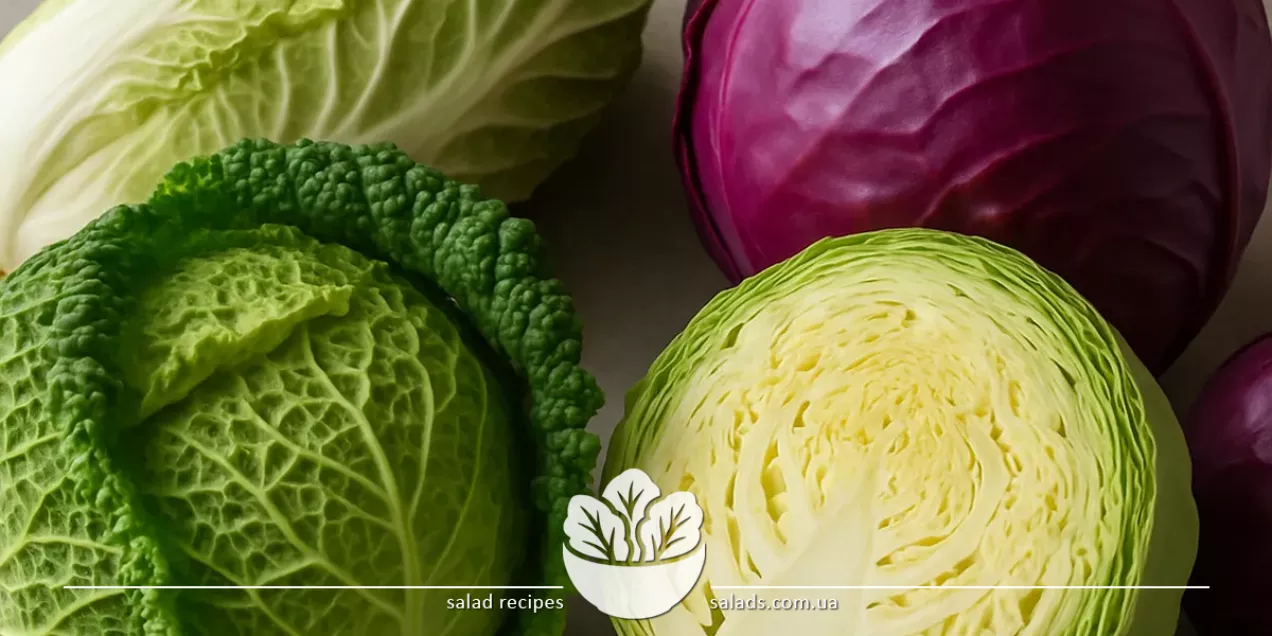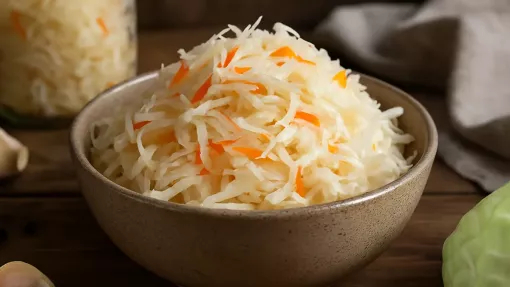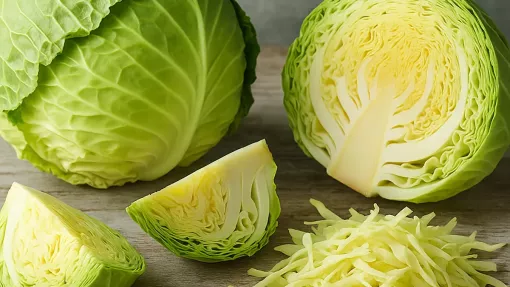Cabbage

Cabbage is one of the most common vegetables and includes a wide range of varieties, each with unique features. From crunchy white cabbage to tender broccoli or cauliflower, cabbage serves as a base for many salads, sides, soups, and main dishes. It can be eaten fresh, braised, baked, boiled, or fermented, often combined with meat, grains, mushrooms, and spices. Besides its flavor, cabbage is a rich source of fiber, vitamins, and micronutrients. Learn more about other vegetables in the vegetables category.
Different Types of Cabbage
Classification of Cabbage and Its Culinary Uses
Cabbage is divided into dozens of varieties, each with its own culinary purpose. The most well-known is white cabbage, which can be eaten raw or cooked – braised, boiled, or baked. Its dense structure helps it keep its shape during long cooking, making it ideal for stuffed cabbage rolls, borscht, solyanka, or braised sides. Raw, it pairs well with carrots, apples, vinegar, and sour cream. Red cabbage is similar in structure but has firmer leaves and a deep purple hue. It contains anthocyanins – natural antioxidants that give it a reddish-violet color. Red cabbage is great in salads, with its crunchy texture and mild bitterness that balance well with sweet or tangy dressings.
Savoy cabbage has a looser head and soft, crinkled leaves. Its delicate texture makes it perfect for fillings or light vegetable dishes. Kohlrabi is a cabbage with a thickened stem resembling a root vegetable. It has a mild, slightly sweet flavor and is good for salads, braising, or roasting. Chinese cabbage is another popular variety, widely used in Asian cuisine, especially for making kimchi, soups, and salads. Cauliflower, made up of fleshy florets, is another common form. It’s great for boiling, baking with sauce, or breading. It’s often combined with other vegetables like cucumber to make light appetizers or pickles.
Cabbage in Salads, Side Dishes, and Soups
Cabbage is traditionally a base ingredient in a wide range of salads. Raw, it retains a crunchy texture, pairs well with sweet and sour ingredients, and absorbs dressings easily. Classic examples include shredded white cabbage with carrots, salt, and vegetable oil, or Chinese cabbage with corn and dressing. Red cabbage is used in salads with apples, beets, feta cheese, or vinegar- or mustard-based sauces. Cooking cabbage enhances its flavor profile. Braised white cabbage with carrots, onions, tomatoes, and spices makes for a hearty dish that can serve as a side or a standalone meal. Combined with potatoes or meat, cabbage becomes the base for casseroles, pies, and stews. Cauliflower is boiled or baked in cream sauce and served as a side with fish, poultry, or meat patties.
Cabbage is essential in soups: Ukrainian borscht wouldn’t be the same without it, nor would kapusniak or solyanka. Thanks to its fibrous texture, it doesn’t overcook quickly and retains a light texture even after long simmering. Broccoli and cauliflower are often used in light soups – they’re soft, easy to digest, and go well with other ingredients. Broccoli is also used in puréed soups or to add color to vegetable dishes. Cabbage’s versatility makes it compatible with many vegetables, especially tomatoes. Tomatoes add acidity, color, and juiciness, making them a common pairing with cabbage in salads, braised dishes, or casseroles.
Sauerkraut and Other Fermentation Methods
Fermentation is one of the oldest methods of preserving cabbage, while also altering its flavor, texture, and nutritional value. During natural fermentation, the sugars in cabbage turn into lactic acid, a natural preservative. The result is a crunchy, slightly sour product rich in probiotics that support gut health. A classic sauerkraut recipe requires just three ingredients: cabbage, salt, and carrots. Sometimes cranberries, apples, caraway seeds, bay leaves, or peppercorns are added. The proportions, cutting method, and fermentation time vary by regional tradition. At home, fermentation usually takes 3-7 days at room temperature, after which the cabbage is stored in the refrigerator or cellar. It can last for months while maintaining its taste and crunch.
In addition to the traditional method, quick pickling is also popular – cabbage is covered with a hot marinade containing vinegar, sugar, and spices. This version is ready to eat the next day. Korean kimchi has a special place – it’s fermented with garlic, ginger, hot pepper, carrots, and fish sauce. It has a bold flavor, spicy heat, and a distinctive aroma. Fermented cabbage pairs well with meat dishes, potatoes, legumes, and grains. It’s served as an appetizer, added to salads, braised, or baked. It’s often combined with aromatic vegetables like sweet peppers, which add color, juiciness, and balance the acidity of sauerkraut.
Stuffed, Baked, and Braised Cabbage
Cabbage is one of the few vegetables that performs just as well when baked or braised as it does raw. The most famous example is stuffed cabbage rolls: white cabbage leaves are used to wrap fillings made from rice, meat, vegetables, or mushrooms. Before cooking, the leaves are blanched to make them pliable and prevent tearing. Rolls are baked or braised in sauces, typically tomato or cream-based. Stuffing isn’t limited to leaves – whole heads of miniature cabbage, like Brussels sprouts, can be roasted with sauce or bacon. Broccoli and cauliflower are baked in cream sauce under a cheese crust or breadcrumbs. These dishes can be served as sides or main courses.
Braised cabbage is another classic preparation. It can be cooked in a skillet, pot, or slow cooker. The base of cabbage is combined with carrots, onions, tomato paste, spices, and sometimes meat or sausages. The result is a flavorful, tender, juicy dish that pairs well with grains or potatoes. Vegetarian versions include mushrooms, beans, or herbs. Cauliflower or broccoli can be stir-fried with eggs, soy sauce, and garlic. These dishes often use aromatic additions, most commonly onion, which adds sweetness and flavor and helps create a caramelized base. It can be used raw, sautéed, or fried depending on the desired result.
Choosing, Storing, and Preparing Cabbage
To get the best flavor and texture from cabbage, it's important to choose and store it correctly. For white cabbage, select firm heads with smooth, tight leaves and no dark spots or cracks. Young heads are more tender but have a shorter shelf life. Red cabbage should be heavy, with a deep purple color and no signs of drying out. For broccoli and cauliflower, the florets should be tight and free of yellowing, with a fresh, firm base. White and red cabbage can be stored in a cool, dark place or the fridge for several weeks. Cauliflower and broccoli are more perishable – best used within 3-5 days of purchase. To prevent moisture loss, store heads in perforated bags or wrapped in paper. Once cut, leftovers should be sealed tightly to avoid drying out.
Before cooking, cabbage is cleaned of outer leaves, rinsed under running water, and sometimes soaked in salty water to remove any pests. Broccoli and cauliflower are broken into florets, rinsed, and blanched if they’ll be frozen or gently cooked. Keep in mind that cabbage has a strong natural aroma, so it’s best paired with neutral or mild seasonings. One classic complement to cabbage is garlic – used in marinades, salads, braised, or fermented dishes, it adds depth and vibrant accents to the flavor. When ingredients are chosen thoughtfully, the full culinary potential of this simple yet versatile vegetable is revealed.

